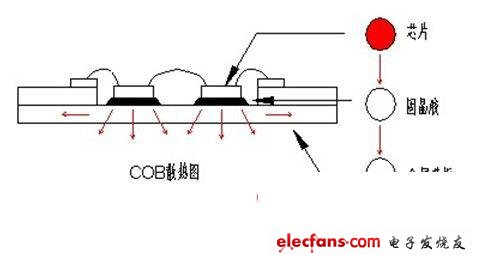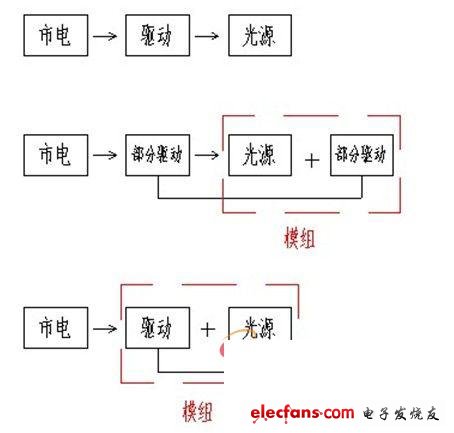Explain in detail the packaged COB products for you
With the continuous innovation of LED packaging technology and the implementation of energy saving and emission reduction policies at home and abroad, the proportion of LED light source applications in the lighting field is increasing, and new packaging forms are constantly being introduced. Ouyang Minghua, a senior engineer at Yuan Lei, said: "The performance of LEDs in terms of heat dissipation, light efficiency, reliability, and cost performance is still a concern. If these cannot be broken through, or if there are new products other than LEDs in the future, then lighting The field may not choose LEDs. "COB (Chip on Board) is the LED package product launched by the industry under this background. Compared with traditional discrete LED package products, it has better heat dissipation capacity and high density. Luminous flux output. In addition to explaining some of the characteristics of COB, this article focuses on how to improve the light efficiency of COB from the basic principles, and seeks to meet the core value points of lighting.
COB has good heat dissipation capacity
When designing the LED package structure, the junction temperature of the chip should be reduced as much as possible. COB packaged chips have the shortest heat dissipation path, which can quickly transfer the heat of the chip to the metal substrate and then to the heat sink. Therefore, COB has better heat dissipation capacity than traditional discrete component assembly. At present, the materials of COB metal substrates are copper, aluminum, aluminum oxide, aluminum nitride, etc. In terms of overall cost, heat dissipation capacity, anti-corrosion, etc., aluminum is mainly used as the metal substrate to make COB. The following picture shows Yuan Lei COB products Structural drawing.

COB can achieve high-density luminous flux output
When we use LEDs in modular design, we usually don't have much space for the light source. At the same time, we hope to have a sufficiently high brightness output in a small size. This solution is almost not found on discrete components LEDs. Of course, some possibilities Will choose 3535 ceramics or other products with small size and relatively high luminous flux, but they are not comparable to the high-density luminous flux output of COB or MCOB. So the advantages of COB in product modularization are reflected: it helps modular design and maintains a higher luminous flux.
The drive design of COB is very flexible, and the application side can select the COB in combination with the existing driving conditions to meet various solutions from low pressure to high pressure.

COB three modular design drawings
Disadvantages of COB packaging
Although COB has many advantages, it is currently not the mainstream in the lighting market. While we are currently optimistic about COB, we should also see the shortcomings behind it in order to find the reasons that restrict its application. First of all, the light efficiency of COB is still low. Because the COB emits light on a plane, it cannot have a PPA to output the side light of the chip as a discrete LED, resulting in partial light loss. Secondly, there is currently no standardized appearance of COB. Most domestic manufacturers manufacture COB according to their respective partners, match the corresponding lamps and driving methods, and the appearance of each one is not uniform, which limits the large-scale use of COB.
Ways to improve COB light efficiency
Based on the problem of low COB light efficiency, the author believes that the solution should be considered from the principle of the substrate. Improvement of LED package light efficiency We usually talk about external quantum efficiency, that is, how to increase the luminous flux of packaged products or the entire module when the chip is the same. First, the material of the substrate with high reflectivity and the reflectivity of the chip placement area directly affect the entire luminous flux output. Whether it is a copper substrate, an aluminum substrate, or a ceramic substrate, this rule must be followed. And it must be noted that when the COB is assembled and applied, the area outside the light emitting surface of the substrate should also be considered. If the reflector is not added to the light emitting surface, the area outside the light emitting surface should be added with the reflective material. Secondly, large particles, high-brightness phosphors, and high-transmittance encapsulated silica gel are the same as traditional discrete LED light efficiency enhancement methods. Thirdly, the chip spacing and driving method should be reasonable during solid crystal bonding. Under the same power, the scheme of driving current should be as small as possible to avoid staying too much heat inside the substrate. In addition, when the size of the light-emitting surface is small, the lens shape silica gel on the surface of the phosphor powder can not only increase the angle, but also further improve the light efficiency.


to sum up
Our understanding of LEDs should return to ordinary electronic components, just like capacitors and resistors, except that LEDs play the role of light emission, and other components play different functions to form an electronic system, as long as the entire system sends out The light output meets the market's value requirements. It is not bad to choose COB.
Fuji Nozzle
Original new and used ones, in stock, fast delivery, top quality.
Supply the following series FUJI Nozzle
FUJI CP7 CP8 NOZZLES
FUJI XP NOZZLES
FUJI NXT NOZZLES
FUJI XPF NOZZLES
Nozzles For I-Pulsemachine
Smt I-Pulse Nozzle
Fuji Nozzle
Smt Fuji Nozzle
SMT Nozzle
Smt Parts Nozzle
Smt Spare Parts Nozzle
FUJI Nozzle
Fuji Nozzle,High Pressure Fuji Nozzle,Nozzles For Fuji Machine,Smt Fuji Nozzle
Shenzhen Srisung Technology Co.,Limited , https://www.sr-smt.com
